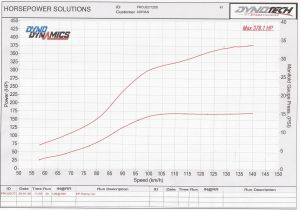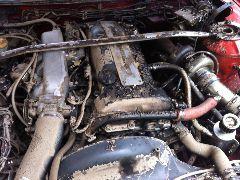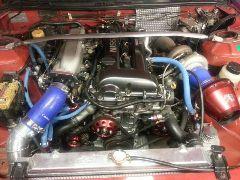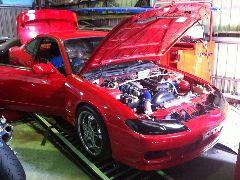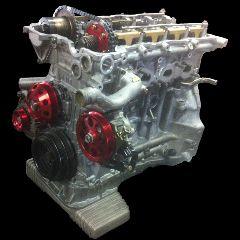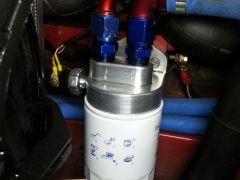
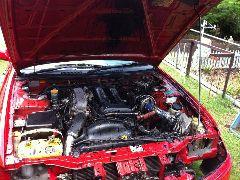
The spark plugs were removed so the engine could be cranked over to eject water from the cylinder bores. Unfortunately the starter motor had corroded internally and had to be stripped down first.
Over 15 litres of oil and water were drained from inside the sump and nearly 20 litres of old engine oil and diesel put back. The reason for putting so much oil back into the motor was so it would fill the engine up to the top of the block and displace any water and moisture from within. In 2 weeks time this brew was drained and replaced with conventional engine oil. Unfortunately the surplus oil found its way past the rings into one of the cylinders, when the engine was cranked over with the spark plugs removed it exploded every where . . . OOops
|
Make : Garrett Model : GT2860RS (Disco Potato) Part Number : 739548-5010S Turbine : 0.86 Compressor : 0.60 813714-006
The turbocharger is mounted on a custom build stainless steel top mount manifold. After blowing several manifold to turbo gaskets I gave up and spent a few hours with a file and some grinding paste lapping the two surfaces so no gasket is required. All oil and water lines are stainless steel braided teflon hose with swaged fittings. The original lines were braided rubber and they all perished due to the high temperatures.
Data Sheets - |
 |
When the SR20 engine was first re-built, it was dyno tuned so it would run correctly but nothing much was done to extract a lot of horse power. It produced 235 HP at the rear wheels.
March 2014 : After fitting a Haltech Wideband O2 sensor and a Haltech Boost Control Solenoid it was time to have the engine dyno tuned again to extract some more power. The first runs proved the engine was still producing the same HP curve then 2 Key parameters were changed.
1) The VVT was enabled - This gave an extra 30 HP at the rear wheels around 4000 RPM with very little impact on the maximum HP @ 6500 RPM
2) The boost was increased from a flat 11 PSI to 16 PSI @ 4000 RPM with a roll off to 14.5 PSI at 6500 RPM. This added an extra 70 HP @ 4000 RPM and 40HP @ 6500 RPM - Total increase of 100HP @ 4000RPM.
August 2014 : Since the previous dyno session I had fixed several leaks in the turbo plumbing which had slowly increased the boost pressure. I ended up blowing the turbo to pieces and whilst no one can give me a definitive reason why the Turbo failed the cause of failure was clearly overheating so I decided the engine tune needed some more extensive investigation. The guys at Signature Performance found a few more leaks around the throttle body. I also had a Haltech intake air sensor fitted and the OEM water temp sensor replaced with a Haltech item. Testing revealed a dicky injector and an intermittent electrical fault on the CAS. New Injectors have been fitted and the CAS connector replaced.
September 2017 : The engine was stripped down and checked for any possible issues. Nothing nasty was found during the strip down rebuild but a few minor changes were made internally. A fresh Dyno Tune seemed like the right thing to do and this time we achived a result of 298HP on standard boost. I decided to leave it on standard boost until I can upgrade to bigger injectors and E85
January 2020 : After the conversion to E85 fuel it was time for a trip back to the dyno. A few basic settings that were changed included upping the fuel pressure from 35psi to 45psi (3 bar). The timing was advanced another 3deg and the boost increased to 15psi from the standard 10psi. The over all result was 378HP which im pretty happy with. 15psi is a safe option, I wasn't keen on going into the silly boost figues just to get a big HP number and risk destroying the engine. I want to have some fun racing
|
When I purchased the car it was fitted with an EMS Stinger ECU running in piggy bank mode. As both the Nissan and EMS units had failed I decided to replace them both with a single ECU. During the initial engine rebuild I fitted a Haltech Sprint 500 ECU. The Sprint 500 does not have all the features of the Platinum series ECU's but as this was a basic track vehicle the Sprint 500 is all that was required. The Haltech ECU was dyno tuned by Signature Performance. |
|
| Jan 2014 : | Fitted a Haltech wideband O2 sensor. At the moment its only used for tuning and logging data via the IQ3 Dash |
| March 2014 : | Fitted a Haltech Boost Control Solenoid |
| August 2014 : | Fitted a Haltech Intake Air Temperature Sensor and replaced the Nissan Water Temp Sensor with a Haltech one. |
| The first dyno session did not go so well - The engine eventually ran several of its bearings, probably caused by corrosion on the crank. Luckily Mick noticed the slight power drop and stopped the engine before it completely destroyed itself by throwing a con rod.
So it was engine out and re-build time. Aside from damaging the bearings and con rods, the crank shaft was also bent and a replacement crank was sourced from another engine. |
|
||
| Bottom End |
|
||
| Cylinder Head |
|
||
| Cam Shafts |
|
||
| Other Bits |
|
||

